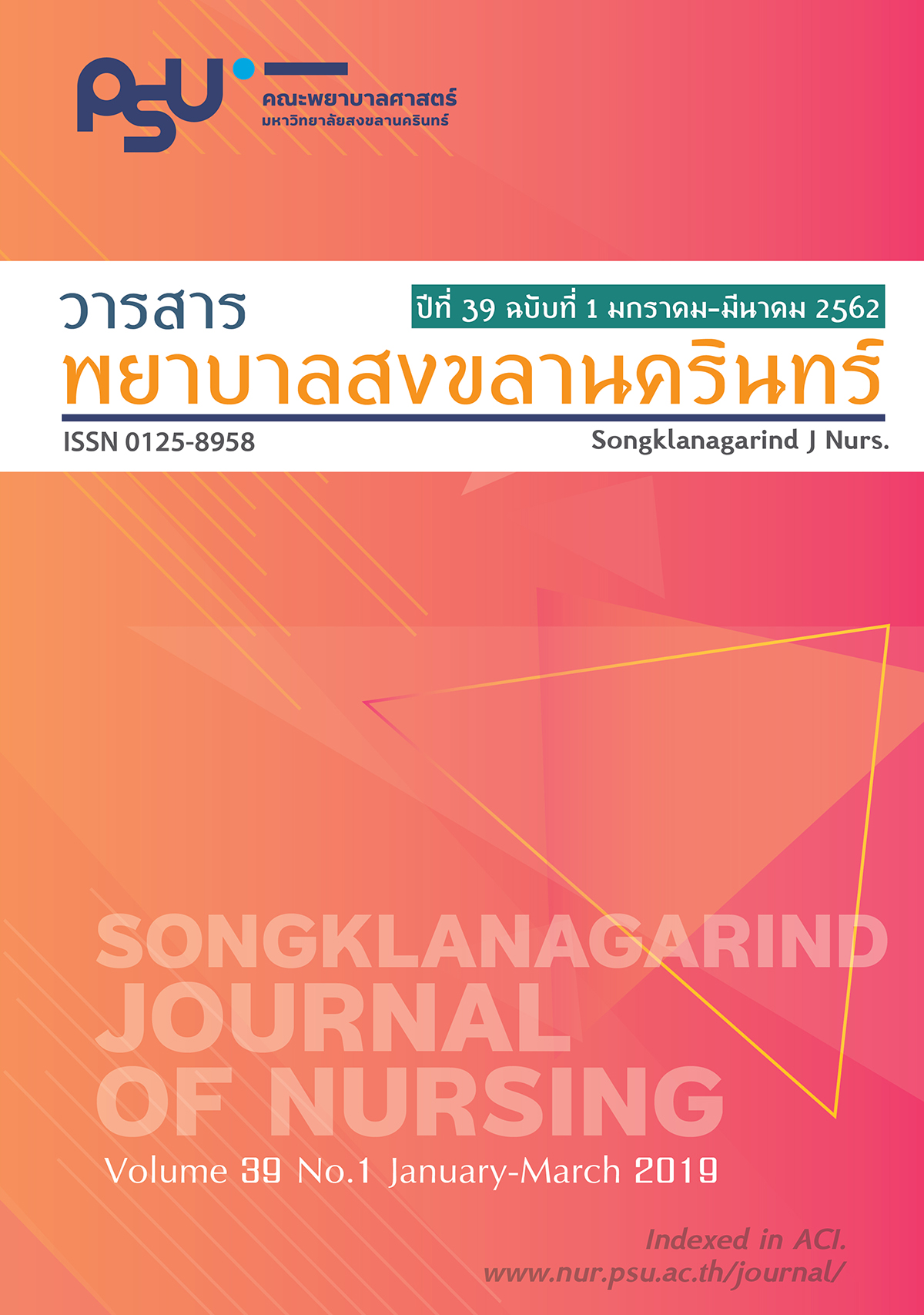โปรแกรมการดูแลระยะท้ายเพื่อส่งเสริมการตายดี ในผู้ป่วยมะเร็ง: ทบทวนวรรณกรรม
Main Article Content
บทคัดย่อ
บทความวิชาการนี้ มีวัตถุประสงค์เพื่อนำเสนอและอภิปรายโปรแกรมการดูแลผู้ป่วยระยะท้ายเพื่อส่งเสริมการตายดีในผู้ป่วยมะเร็ง โดยได้สืบค้นงานวิจัยจากฐานข้อมูล ได้แก่ CINAHL Plus with Full text, Sciences Direct, ProQuest, PubMed, และ Wiley ระหว่างปี ค.ศ. 2007-2017 คำสำคัญที่ใช้ในการสืบค้น ได้แก่ cancer patients OR oncology patients OR patients with cancer AND palliative care program OR end of life program OR effective palliative care program AND good death OR quality of death และได้คัดเลือกงานวิจัยที่เกี่ยวข้องได้ทั้งหมด 7 เรื่อง ทำการวิเคราะห์ และพบว่า แนวคิดที่ใช้เป็นกรอบในการสร้างโปรแกรมมี 7 แนวคิด ได้แก่ 1) การดูแลผู้ป่วยเรื้อรัง 2) การจัดการรายกรณี 3) การจัดการตนเอง 4) การสร้างเสริมพลังอำนาจในตนเอง 5) การจัดการอาการ 6) การบำบัดทางจิต และ 7) แนวทางการสื่อสาร กิจกรรมการดูแลในโปรแกรม ประกอบด้วย การจัดการอาการปวดและความไม่สุขสบายทั้งทางร่ายกาย และจิตใจ การเสริมสร้างพลังอำนาจ การพูดคุยเพื่อลดความกังวลหรือซึมเศร้า และ การติดตามทางโทรศัพท์ ระยะเวลาในการจัดกิจกรรมครั้งละ 30-60 นาที ระยะเวลาตลอดโปรแกรมอยู่ในช่วง 2 ถึง 6 เดือน ผลของโปรแกรม พบว่า ระดับความปวด ความไม่สุขสบายดีขึ้น คุณภาพชีวิตทั้งทางด้านร่างกาย จิตใจ และจิตวิญญาณ และมีความผาสุกในระยะท้ายของชีวิตเพิ่มขึ้น โปรแกรมเหล่านี้สามารถนำไปใช้ในคลินิกเพื่อส่งเสริมการตายดี
Article Details
เอกสารอ้างอิง
WHO. World Health Organization 2014: Cancer. [Available from: https://www.who.int/news-room/ fact-sheets/detail/cancer.
American Association for Cancer Research. AACR cancer progress report 2016. Clin Cancer Res 2016; 22 (supplement 1): s1-s137. Doi: 10.1158/ 1078-0432.CCR-16-1993
Leelasiri A. End of life care. RTA Med J. 2554; 64: 97-102. Thai.
Victoria Hospice Society. The Palliative Performance Scale version 2 (PPSv2) tool. J Pall Care. 1996; 9(4): 26-32.
Kurat S, Parakho P, Suwannakoat S. End of life care: New dimension challenges the role of nurse. Nonthaburi: Sri Maha Sarakham College of Nursing in Ministry of Public Health; 2013. Thai.
Berry PH, Kuebler, K. K., & Heidrich, D. E. End of life care clinical practice guidelines. Philadelphia W.B. Saunders; 2002.
Chaithanasarn A. Manual of end of life care and family. Bangkok: Beyond enterprice company; 2016. Thai.
Laurujisawat P. Psychiatic assessment and management in palliative care. In: End of life care improving care of the dying. 2 nd ed. Bangkok: Aksorn sampan press; 2010. Thai.
Nilmanat K. The end of life care. Orange media: Songkhla; 2012. Thai.
Murakawa Y, Nihei Y. Understanding the concept of a ‘good death’ in Japan: Differences in the views of doctors, palliative and non-palliative ward nurses. Int J Palliat Nurs. 2009; 15(6): 282-9. doi:10.12968/ijpn.2009.15.6.42987
Kunsongkeit W. Good death as perceived by the patients’family member. The Journal of Faculty of Nursing Burapha University. 2015;23(3):41- 55. Thai.
Kunsongkeit W. Good death as perceived by the patients. The journal of Faculty of Nursing Bu- rapha University. 2554; 19(2): 1-12.
Kongsuwan W. Nursing for critically ill patients at the end stage of life with technology. Songkhla: Chanmuang Press; 2015. Thai.
Lertsanguansinchai P, Nuchprayoon I, Chatkaew P, Sittipunt C. End of life care improving care the dying. Bangkok; Aksorn sampan press 1987 Thai.
Granda-Cameron C, & Houldin, A. Concept analysis of good death in terminally ill. Am J Hosp Palliat Care. 2012; 29(8): 632-9. doi: 10.1177/1049909111434976
Polit & Beck. Resource manual for nursing research generating and assessing evidence for nursing practice. 9 ed: Lippincott Company; 2012.
Xiao H, Kwong E, Pang S, Mok E. Effect of a life review program for Chinese patients with advanced cancer: A randomized controlled trial. Cancer Nurs. 2013;36(4):274-83. doi:10.1097/ NCC.0b013e318268f7ba
Greer JA, Jackson VA, Meier DE, Temel JS. Effect of early integration of palliative care services with standard oncology care for patients with advanced cancer. CA Cancer J Clin. 2013; 63(5): 349-63. doi: 10.3322/caac.21192
Bakitas M, Lyons KD, Hegel MT, et al. The project ENABLE II randomized controlled trial to improve palliative care for rural patients with advanced cancer: baseline findings, methodological challenges, and solutions. Palliat Support Care. 2009; 7(1): 75-86. doi: 10.1017/S1478951509000108
Lo C, Hales S, Rydall A, Panday T, Chiu A, Malfitano C, et al. Managing cancer and living meaningfully: Study protocol for a randomized controlled trial. Trials. 2015; 16(1): 391. doi: 10. 1186/s13063-015-0811-1
Chan WCH, Epstein I. Researching “Good Death” in a Hong Kong palliative care program: A clinical data mining study. OMEGA (westport). 2012; 64(3): 203-22. doi.org/10.2190/OM.64.3.b
Shao-Yi Cheng SD, Wen-Yu Hu, Ching-Yu Chen, and Tai-Yuan Chiu. Factor affecting the improvement of quality of dying of terminally ill patients with cancer through palliative care: A ten-year experince. J Palliat Med. 2012; 15 (8): 854-62.
Kehl KA. Moving toword peace: An analysis of the concept of a good death. Am J Hosp Palliat Care. 2006; 23(4): 277-86. doi: 10.1177/ 1049909106290380
Bernacki R, Hutchings M, Vick J, et al. Development of the serious illness care program: A randomised controlled trial of a palliative care communication intervention. BMJ Open. 2015; 5(10). doi: 10.1136/bmjopen-2015-009032
Bakitas M, Lyons K, Hegel MT, et al. Effects of a palliative care intervention on clinical outcomes in patients with advanced cancer: The Project ENABLE II randomized controlled trial. JAMA. 2009; 302(7): 741-9. doi: 10.1001/ jama.2009.1198
Tongprateep T. Nurse: Being with the dying. 2 nd ed. Bangkok: V print 1991; 2010. Thai.
Tsai J-S, Wu C-H, Chiu T-Y, Hu W-Y, Chen C-Y. Fear of death and good death among the young and elderly with terminal cancers in Taiwan. J Pain Symptom Manage. 2005; 29 (4): 344-51. doi: 10.1016/j.jpainsymman.2004. 07.013
Cella DF, Tulsky DS, Gray G, Sarafian B, Linn E, Bonomi A, et al. The functional assessment of cancer therapy scale: Development and validation of the general measure. J Clin Oncol. 1993; 11(3):570-9. doi:10.1200/JCO.1993.11.3.570
Lyons KD ea. Reliability and validity of the functional assessment of chronic illness therapy- palliative care scale. J Pain Symptom Manage. 2009; 37(1): 23-32. doi: 10.1016/j.jpainsymman
Sumdaengrit B, Limthongkul M. Factor predicting quality of life in breast cancer patients after treatment in university hospital. J Nurs health. 2014; 32(4): 85-93. Thai.


